Vienna ( vee-EN-ə; German: Wien [viːn] ; Austro-Bavarian: Wean [veɐ̯n]) is the capital, largest city, and one of nine federal states of Austria. Vienna is Austria's most populous city and its primate city, with about two million inhabitants (2.9 million within the metropolitan area, nearly one-third of the country's population), and its cultural, economic, and political center. It is the fifth-largest city proper by population in the European Union and the largest of all cities on the Danube river by population.
The city lies on the east...Read more
Vienna ( vee-EN-ə; German: Wien [viːn] ; Austro-Bavarian: Wean [veɐ̯n]) is the capital, largest city, and one of nine federal states of Austria. Vienna is Austria's most populous city and its primate city, with about two million inhabitants (2.9 million within the metropolitan area, nearly one-third of the country's population), and its cultural, economic, and political center. It is the fifth-largest city proper by population in the European Union and the largest of all cities on the Danube river by population.
The city lies on the eastern edge of the Vienna Woods (Wienerwald)—the northeasternmost foothills of the Alps, that separate Vienna from the more western parts of Austria—at the transition to the Pannonian Basin. It sits on the Danube, and is also traversed by the highly regulated Wienfluss (Vienna River). Vienna is completely surrounded by Lower Austria, and lies around 50 km (31 mi) west of Slovakia and its capital Bratislava, 60 km (37 mi) northwest of Hungary, and 60 km (37 mi) south of Moravia (Czech Republic).
The once Celtic settlement of Vedunia was converted by the Romans into the castrum and canaba Vindobona (province of Pannonia) in the 1st century, and was elevated to a municipium with Roman city rights in 212. This was followed by a time in the sphere of influece of the Lombards and later the Pannonian Avars, when Slavs formed the majority of the region's population. From the 8th century on, the region was settled by the Baiuvarii. In 976, the Babenbergs established the Margraviate of Austria. In 1221, Vienna was granted city rights by Leopold VI. The reign of the Habsburgs started in 1278. In 1558, Vienna became the capital of the Holy Roman Empire, which it remained until 1806. It was the capital of the Austrian Empire from 1804 to 1867, and of the Cisleithanian part of Austria-Hungary from 1867 to 1918, and subsequently became the capital of Austria.
Until the beginning of the 20th century, Vienna was the largest German-speaking city in the world, and before the splitting of the Austro-Hungarian Empire in World War I, the city had two million inhabitants. Today, it is the second-largest German-speaking city after Berlin. Vienna is host to many major international organizations, including the United Nations, OPEC and the OSCE. In 2001, the city center was designated a UNESCO World Heritage Site. In July 2017 it was moved to the list of World Heritage in Danger.
Vienna has been called the "City of Music" due to its musical legacy, as many famous classical musicians such as Beethoven, Brahms, Haydn, Mahler, Mozart, Schoenberg, Schubert and Johann Strauss called Vienna home. It is well known for having played a pivotal role as a leading European music center, from the age of Viennese Classicism through the early part of the 20th century. Vienna is also said to be the "City of Dreams" because it was home to the world's first psychoanalyst, Sigmund Freud. The historic center of Vienna is rich in architectural ensembles, including Baroque palaces and gardens, and the late-19th-century Ringstraße lined with grand buildings, monuments and parks.
Evidence has been found of continuous habitation in the Vienna area since 500 BC, when Celts settled the site on the Danube.[1] In 15 BC, the Romans fortified the frontier city they called Vindobona to guard the empire against Germanic tribes to the north.
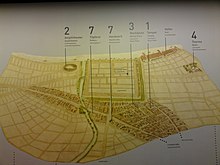 Overview of the Roman legion settlement Vindobona in the center of today's Vienna
Overview of the Roman legion settlement Vindobona in the center of today's ViennaClose ties with other Celtic peoples continued through the ages. The Irish monk Saint Colman (or Koloman, Irish Colmán, derived from colm "dove") is buried in Melk Abbey and Saint Fergil (Virgil the Geometer) served as Bishop of Salzburg for forty years. Irish Benedictines founded twelfth-century monastic settlements; evidence of these ties persists in the form of Vienna's great Schottenstift monastery (Scots Abbey), once home to many Irish monks.
In 976, Leopold I of Babenberg became count of the Eastern March, a district centered on the Danube on the eastern frontier of Bavaria. This initial district grew into the duchy of Austria. Each succeeding Babenberg ruler expanded the march east along the Danube, eventually encompassing Vienna and the lands immediately east. In 1145, Henry II, Duke of Austria moved the Babenberg family residence from Klosterneuburg in Lower Austria to Vienna. From that time, Vienna remained the center of the Babenberg dynasty.[2]
In 1440, Vienna became the resident city of the Habsburg dynasty. It eventually grew to become the de facto capital of the Holy Roman Empire (800–1806) in 1437 and a cultural center for arts and science, music and fine cuisine. Hungary occupied the city between 1485 and 1490.
 Depiction of Vienna in the Nuremberg Chronicle, 1493
Depiction of Vienna in the Nuremberg Chronicle, 1493 Vienna in 1683
Vienna in 1683In the 16th and 17th centuries, Christian forces twice stopped Ottoman armies outside Vienna, in the 1529 siege of Vienna and the 1683 Battle of Vienna. The Great Plague of Vienna ravaged the city in 1679, killing nearly a third of its population.[3]
Austrian Empire and the early 20th century Vienna from Belvedere by Bernardo Bellotto, 1758
Vienna from Belvedere by Bernardo Bellotto, 1758In 1804, during the Napoleonic Wars, Vienna became the capital of the newly formed Austrian Empire. The city continued to play a major role in European and world politics, including hosting the Congress of Vienna in 1814–15. The city also saw major uprisings against Habsburg rule in 1848, which were suppressed. After the Austro-Hungarian Compromise of 1867, Vienna remained the capital of what became the Austro-Hungarian Empire. The city functioned as a center of classical music, for which the title of the First Viennese School (Haydn/Mozart/Beethoven) is sometimes applied.
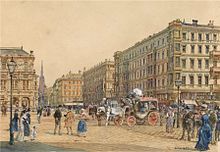 Vienna's Ringstraße and the State Opera in around 1870
Vienna's Ringstraße and the State Opera in around 1870 Color lithograph of Vienna, 1900
Color lithograph of Vienna, 1900During the latter half of the 19th century, Vienna developed what had previously been the bastions and glacis into the Ringstraße, a new boulevard surrounding the historical town and a major prestige project. Former suburbs were incorporated, and the city of Vienna grew dramatically. In 1918, after World War I, Vienna became capital of the Republic of German-Austria, and then in 1919 of the First Republic of Austria.
From the late-19th century to 1938, the city remained a center of high culture and of modernism. A world capital of music, Vienna played host to composers such as Brahms, Bruckner, Mahler and Richard Strauss. The city's cultural contributions in the first half of the 20th century included, among many, the Vienna Secession movement in art, the Second Viennese School, the architecture of Adolf Loos, the philosophy of Ludwig Wittgenstein, and the Vienna Circle.
Red Vienna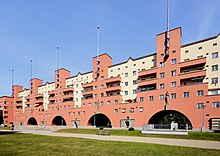 The Karl-Marx-Hof remains symbolic for Red Vienna
The Karl-Marx-Hof remains symbolic for Red ViennaThe city of Vienna became the center of socialist politics from 1919 to 1934, a period sometimes referred to as "Red Vienna" (Das rote Wien). After a new breed of socialist politicians won the local elections they engaged in a brief but ambitious municipal experiment.[4] Social democrats had won an absolute majority in the May 1919 municipal election and ruled the city council with 100 of the 165 seats. Jakob Reumann was appointed by the city council as city mayor.[5] The theoretical foundations of so called Austromarxism were established by Otto Bauer, Karl Renner, and Max Adler.[6]
In the Austrian Civil War of 1934 Chancellor Engelbert Dollfuss sent the Austrian Armed Forces to shell civilian housing such as the Karl Marx-Hof occupied by the Republikanischer Schutzbund (socialist militia).
Anschluss and World War II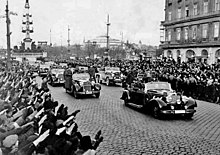 Crowds greet Adolf Hitler as he rides in an open car through Vienna in March 1938.
Crowds greet Adolf Hitler as he rides in an open car through Vienna in March 1938.In 1938, after a triumphant entry into Austria, the Austrian-born German Chancellor Adolf Hitler spoke to the Austrian Germans from the balcony of the Neue Burg, a part of the Hofburg at the Heldenplatz. In the ensuing days the new Nazi authorities oversaw the harassment of Viennese Jews, the looting of their homes, and their on-going deportation and murder.[7][8] Between 1938 (after the Anschluss) and the end of the Second World War in 1945, Vienna lost its status as a capital to Berlin, because Austria ceased to exist and became part of Nazi Germany.
During the November pogroms on 9 November 1938, 92 synagogues in Vienna were destroyed. Only the city temple in the 1st district was spared, as the data of all Jews in Vienna were collected in the adjacent archives. Adolf Eichmann held office in the expropriated Palais Rothschild and organized the expropriation and persecution of the Jews. Of the almost 200,000 Jews in Vienna, around 120,000 were driven to emigrate and around 65,000 were killed. After the end of the war, the Jewish population of Vienna was only about 5,000.[9][10][11][12]
Vienna was also the center of the important resistance group around Heinrich Maier, which provided the Allies with plans for V-1, V-2 rockets, Peenemünde, Tiger tanks, Messerschmitt Bf 109, Messerschmitt Me 163 Komet and other aircraft. The information was important to Operation Crossbow and Operation Hydra, both preliminary missions for Operation Overlord. In addition, factory locations for war-essential products were communicated as targets for the Allied Air Force. The group was exposed and most of its members were executed after months of torture by the Gestapo in Vienna.[13][14][15][16] The group around the later executed Karl Burian even tried to blow up the Gestapo headquarters in the Hotel Metropole.[17]
On 2 April 1945, the Soviet Red Army launched the Vienna Offensive against the Germans holding the city and besieged it. British and American air-raids, as well as artillery duels between the Red Army and the SS and Wehrmacht, crippled infrastructure, such as tram services and water- and power-distribution, and destroyed or damaged thousands of public and private buildings. The Red Army was helped by an Austrian resistance group in the German Wehrmacht. The group tried under the code name Radetzky to prevent the destruction and fighting in the city. Vienna fell eleven days later.[18] At the end of the war, Austria again became separated from Germany, and Vienna regained its status as the capital city of the Republic of Austria, but the Soviet hold on the city remained until 1955,[19][20] when Austria regained full sovereignty.
Four-power Vienna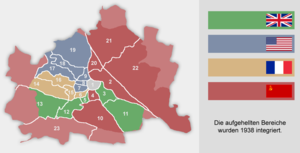 Occupation zones in Vienna, 1945–55
Occupation zones in Vienna, 1945–55After the war, Vienna was part of Soviet-occupied Eastern Austria until September 1945. As in Berlin, Vienna in September 1945 was divided into sectors by the four powers: the US, the UK, France, and the Soviet Union and supervised by an Allied Commission. The four-power occupation of Vienna differed in one key respect from that of Berlin: the central area of the city, known as the first district, constituted an international zone in which the four powers alternated control on a monthly basis. The control was policed by the four powers on a de facto day-to-day basis, the famous "four soldiers in a jeep" method.[21] The Berlin Blockade of 1948 raised Western concerns that the Soviets might repeat the blockade in Vienna. The matter was raised in the UK House of Commons by MP Anthony Nutting, who asked: "What plans have the Government for dealing with a similar situation in Vienna? Vienna is in exactly a similar position to Berlin."[22]
There was a lack of airfields in the Western sectors, and authorities drafted contingency plans to deal with such a blockade. Plans included the laying down of metal landing mats at Schönbrunn. The Soviets did not blockade the city. The Potsdam Agreement included written rights of land access to the western sectors, whereas no such written guarantees had covered the western sectors of Berlin. Also, there was no precipitating event to cause a blockade in Vienna. (In Berlin, the Western powers had introduced a new currency in early 1948 to economically freeze out the Soviets.) During the 10 years of the four-power occupation, Vienna became a hotbed for international espionage between the Western and Eastern blocs. In the wake of the Berlin Blockade, the Cold War in Vienna took on a different dynamic. While accepting that Germany and Berlin would be divided, the Soviets had decided against allowing the same state of affairs to arise in Austria and Vienna. Here, the Soviet forces controlled districts 2, 4, 10, 20, 21, and 22 and all areas incorporated into Vienna in 1938.
Barbed wire fences were installed around the perimeter of West Berlin in 1953, but not in Vienna. By 1955, the Soviets, by signing the Austrian State Treaty, agreed to relinquish their occupation zones in Eastern Austria as well as their sector in Vienna. In exchange they required that Austria declare its permanent neutrality after the allied powers had left the country. Thus they ensured that Austria would not be a member of NATO and that NATO forces would therefore not have direct communications between Italy and West Germany.
The atmosphere of four-power Vienna is the background for Graham Greene's screenplay for the film The Third Man (1949). Later he adapted the screenplay as a novel and published it. Occupied Vienna is also depicted in the 1991 Philip Kerr novel, A German Requiem.
Austrian State Treaty and afterwards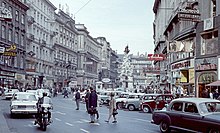 Graben in 1966
Graben in 1966The four-power control of Vienna lasted until the Austrian State Treaty was signed in May 1955. That year, after years of reconstruction and restoration, the State Opera and the Burgtheater, both on the Ringstraße, reopened to the public. The Soviet Union signed the State Treaty only after having been provided with a political guarantee by the federal government to declare Austria's neutrality after the withdrawal of the allied troops. This law of neutrality, passed in late October 1955 (and not the State Treaty itself), ensured that modern Austria would align with neither NATO nor the Soviet bloc, and is considered one of the reasons for Austria's delayed entry into the European Union in 1995.
In the 1970s, Austrian Chancellor Bruno Kreisky inaugurated the Vienna International Center, a new area of the city created to host international institutions. Vienna has regained much of its former international stature by hosting international organizations, such as the United Nations (United Nations Industrial Development Organization, United Nations Office at Vienna and United Nations Office on Drugs and Crime), the Preparatory Commission for the Comprehensive Nuclear-Test-Ban Treaty Organization, the International Atomic Energy Agency, the Organization of Petroleum Exporting Countries, and the Organization for Security and Cooperation in Europe.

















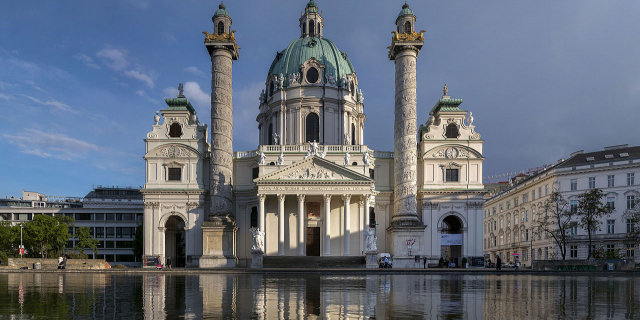








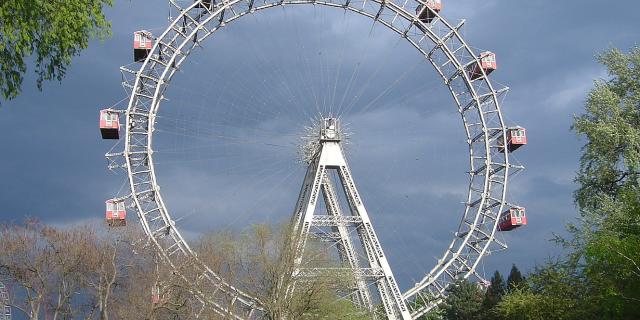





Add new comment